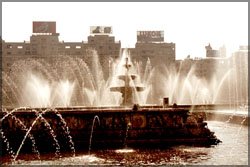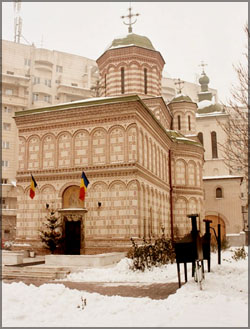|
Little Blue Birdie's Diary

Bucharest's architectural splendour
Dear Diary!
Remember the nice journey we had over the last few weeks? Today is
our last day in the City of Bucharest. This city is a really nice place
full of beautiful tourist attractions.
That's why we had to spend many days visiting these places. Our team
also enjoyed the visits very much. But, on and off we missed our homes,
which made all of us sad. So, we got together and refreshed our memories
about our families. The wonderful places we visited helped us to get
over our home-sickness.
The first place we visited today was the Mihai Voda Church (Biserica
Mihai Voda). Former Romanian dictator Nicolai Ceausescu had ordered the
demolition of all the buildings located in and around Unirii Square to
make way for a civic centre.
The Brancovenesc Hospital, the Sf. Vineri Church, the Sf. Spiridon
Church, the Vacaresti Monastery and many other historic buildings and
monuments as well as lots of private houses had been wiped out. "I don't
know under what circumstances, but a few old churches were spared from
demolition," said Mary, the old bird in the city.
However, some of the buildings had been moved from their initial
locations, and hidden from sight behind the grey apartment complexes of
the new civic centre.
Mihai Voda is one of these churches. It had been moved 280m on rails
and dumped in a backyard behind some blocks of flats. Once a beautiful monastery, built in 1591 by the
great Voivode Michael the Brave, its medieval cloister and old buildings
were demolished and only the church and the gate tower survived. One of
my favourite architectural works was the beautiful sculpted frame of the
main door.
some blocks of flats. Once a beautiful monastery, built in 1591 by the
great Voivode Michael the Brave, its medieval cloister and old buildings
were demolished and only the church and the gate tower survived. One of
my favourite architectural works was the beautiful sculpted frame of the
main door.
Our next place of visit, the Union Square (Piata Unirii), was where
the downtown started. Two of Bucharest's subway lines intersect (cross)
here and the square was the site of one of the city's department stores,
Unirea. Unfortunately, this place had also been Ceausescu's playground
for experimentation, as the square was caught in his plan for 'urbanisation'
and the creation of the Soviet-style Civic Centre.
Another place of visit in the city, the University Square, had
proved, in the last 15 years, to be a popular rallying point at times of
national crises as well as celebrations: people had gathered here during
the 1989 revolution and the sad events of June 1990 and they continue to
gather here every time the national team wins a soccer game.
Visitors may be surprised to see a lot of people loitering around the
underground passage entrance in front of the National Theatre; it's
probably because it's the most popular meeting place in Bucharest. It
was buzzing with crowds and traffic, a true centre of activity.
The square was surrounded by interesting architecture starting with
the University of Bucharest building on the square's north-western
corner. Facing the university, there were four statues of illustrious
(acclaimed) pedagogues (educators) and statesmen. On the northern
corner, adjacent to the Intercontinental Hotel, was the National Theatre
of Bucharest.
 Opposite
it, lay the beautiful building of the School of Architecture, our next
place of visit, behind a little square with a small fountain, where
people stop and sit when the weather is nice. Opposite
it, lay the beautiful building of the School of Architecture, our next
place of visit, behind a little square with a small fountain, where
people stop and sit when the weather is nice.
On the south-western corner of the square, the Bucharest History
Museum traced the history of the city, from the beginning to modern
days. Across it lay the neo-Classical building of the Coltea Hospital
and its lovely church.
In the middle of the square, in a little island, there were ten stone
crosses paying homage to those killed during the 1989 revolution. Below
the square, there was an underground passage with shops and eateries
(eating places) which allowed pedestrians to cross from one side of the
square to another, and also led to the subway station.
The School of Architecture building was conceived by Grigore Cherchez
in 1912 and took five years for completion. By circling the building, I
noticed that it was a hybrid.
The old wing (the one designed by Cherchez), in Brancovenesc style,
is a mixture of Eastern and Renaissance motifs, with richly ornate
(decorated) pillars and carvings. This building was dedicated to Ion
Mincu, who is considered to be one of the greatest Romanian architects.
The new parts of the building have been done in a modern, cold style.
That's all for the moment. I'll write again as soon as I have more
information about other interesting places in the world.
Bye!
Comments: [email protected] |
